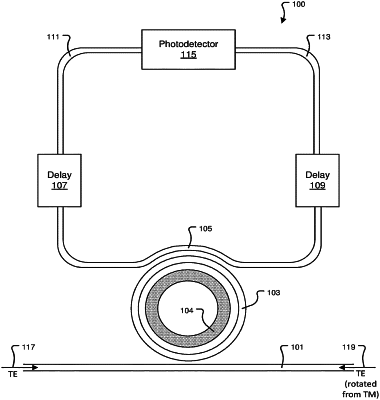| CPC G02B 6/4215 (2013.01) [G02B 6/29335 (2013.01); G02B 6/29338 (2013.01); G02B 6/2938 (2013.01); G02B 6/29395 (2013.01); G02B 6/4213 (2013.01); H04B 10/60 (2013.01); G02B 6/29343 (2013.01)] | 21 Claims |

|
1. An electro-optic receiver, comprising:
a first optical waveguide optically connected to convey a first portion of incoming light in a first direction through the first optical waveguide, the first optical waveguide also optically connected to convey a second portion of incoming light in a second direction through the first optical waveguide, the second direction being opposite of the first direction;
a ring resonator disposed within an evanescent optical coupling distance of the first optical waveguide, such that the first portion of incoming light and the second portion of incoming light couple into the ring resonator from the first optical waveguide, and such that the first portion of incoming light and the second portion of incoming light travel in opposite directions within the ring resonator;
a second optical waveguide disposed within an evanescent optically coupling distance of the ring resonator, such that the first portion of incoming light and the second portion of incoming light couple into the second optical waveguide from the ring resonator, and such that the first portion of incoming light and the second portion of incoming light travel in opposite directions within the second optical waveguide away from the ring resonator;
a photodetector optically connected to both a first end of the second optical waveguide and a second end of the second optical waveguide;
a first optical signal timing delay section disposed along the second optical waveguide at a location between the ring resonator and the first end of the second optical waveguide, the first optical signal timing delay section configured to impart a controlled amount of temporal delay to a first light signal that travels through the first optical signal timing delay section; and
a second optical signal timing delay section disposed along the second optical waveguide at a location between the ring resonator and the second end of the second optical waveguide, the second optical signal timing delay section configured to impart a controlled amount of temporal delay to a second light signal that travels through the second optical signal timing delay section.
|